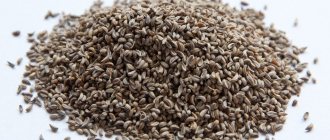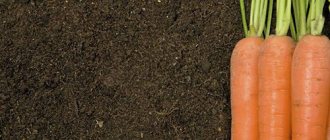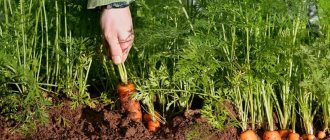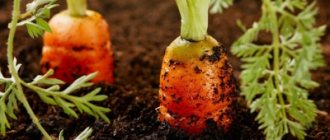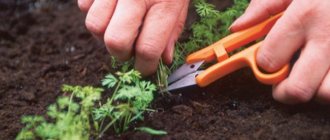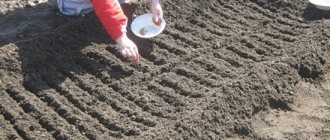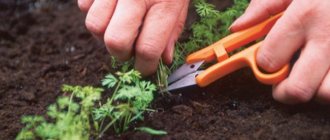Loading…
Loading…
Both novice gardeners and experienced summer residents know that carrots are difficult to grow crops. The first sprouts above the garden bed usually appear no earlier than three weeks later, and their number is much smaller than the seeds embedded in the soil.
Indeed, the abundance of essential oils in small seeds and a fairly strong shell prevent the sprouts from sprouting quickly. And uneven ripening of seeds on the umbrella inflorescence affects germination, which in carrots is no more than 60%.
Therefore, the reason for a lost harvest is often ignorance of simple techniques on how to speed up the germination of carrot seeds, as well as neglect of preliminary sorting of planting material. After all, if the quality of the seedlings does not suit the summer resident, then the reseeded carrots will yield a harvest a month later.
Selecting carrot seeds for sowing
Today, summer residents have a choice between regular seeds and those coated with a protective layer.
How many days does it take for the carrots to sprout in both cases? As a rule, granulated seeds germinate more quickly, but the waiting time for germination can take up to a week. During spring sowing, such seeds with a protective and, at the same time, nutrient-containing shell show good results. If you need to sow carrots at a later date, it is better to use regular seeds, pre-sorted and prepared for planting.
While caring for carrots to sprout faster, we must not forget that the quality of the seeds decreases as they are stored. The best germination rate is for planting material collected last year.
How to choose good seeds?
If you buy seeds, it is better to give preference to manufacturers with a good reputation and reviews from real customers. Pay attention to the packaging; a quality product should contain information: contact information, brief information about the variety and advice on agricultural cultivation techniques, packaging date and expiration date, etc.
Be sure to pay attention to the expiration date; there is no point in buying expired seeds, germination will be zero or very low.
The packaging should not be wrinkled, damaged or dirty. Such signs indicate a possible violation of storage conditions.
Be careful when soaking seeds before planting
Sources covering the topic “How to plant carrots with seeds” often talk about accelerating germination after washing the seeds under running hot water. However, such a shower for carrots is best used as a means of checking germination.
Light dummy seeds become immediately visible and are quickly removed. If you leave full-bodied seeds under the stream, then the nutrients are washed out along with the essential oils that prevent moisture from reaching the embryo. As a result, the seedlings will be obviously weak.
It is more effective not to rinse the seeds in hot water, but to fill them with water at room temperature for 2 days and periodically change the liquid until the seeds swell. It is dangerous to wait for a large number of sprouts to peck, since it is unlikely to be possible to plant small seeds without damaging the fragile sprouts.
If sprouts do appear, then it is better to plant such seeds in already warm soil. To delay the development of seedlings until planting, the seeds are sent to the refrigerator, where they are kept at a temperature of +4 degrees. Before sowing, dry sand is added to small carrot seeds.
Landing rules
To eliminate the fact of lack of germination, it is necessary to prepare the soil correctly and in advance (in the autumn). What is needed for that:
- carry out digging;
- add potassium sulfate (20 grams is enough for 1 sq. m);
- fertilize with superphosphate (put 30 grams per square meter);
- you can purchase a complex fertilizer - nitroammophoska (75-80 grams per square meter);
- loosen the soil in spring;
- It is advisable to add a little peat and sand.
Pelleting
This is an important event to speed up germination. The seed material is enriched with nutrients and microelements. For this purpose, special mixtures are sold in which the grains are soaked. As a result of such actions, a durable shell is formed on the seeds, which dissolves after planting in the ground.
Why coated seeds are better:
- they protect plants from pests and pathogenic microorganisms;
- fast germination is ensured;
- the soil is nourished;
- the development of the root system is accelerated;
- The tops develop faster.
Some modern coating products contain harmful substances. But this is not a reason to refuse them, since during the formation of the root crop these substances are used up. As a result, the fruits will not cause harm to the human body.
Germination
There are two universal ways to germinate seeds that speed up germination:
- Stratification. Place the seed material in a fabric bag, after which you need to make a hole in the soil, the depth of which is 18-20 cm. Place the fabric bag in it and fill it with warm water. Then cover with a layer of soil and cover with snow. Keep the seeds for 14-15 days, then take them out, combine them with an equal amount of sand and sow them in the garden. Stratification is carried out at the end of March - beginning of April.
- Soaking in vodka. Thanks to the alcohol composition, a large number of essential oils are neutralized, which delay the germination of sprouts. As in the previous case, you need to put the grains in a bag, then place it in high-quality vodka for half an hour. Then rinse, dry and plant.
How to speed up the germination of carrot seeds without soaking
There are several ways to make carrots sprout quickly. This helps not only speed up germination, but also harden future plants. If you sprinkle dry seeds in a fabric bag with cold, well-moistened soil, then after 10 days they will swell and sowing them will not be difficult. And knowing how long it takes for carrots to sprout when planted dry, waiting 4-5 days before sprouts appear is also not at all burdensome.
You can do without soaking if you create a kind of nutritious shell for the seeds at home. The procedure should be carried out 3–5 days before sowing the seeds, while pelleting using a soil mixture:
- helps carrots to sprout quickly;
- greatly facilitates sowing;
- reduces seed consumption per unit area;
- facilitates subsequent care of plantings, including weeding, thinning and hilling.
These carrot shoots in the photo are distinguished by their bright green color, strength and uniformity.
The components of the shell composition are:
- infusion of mullein or compost;
- dry peat, ground through a sieve;
- humus.
Dry carrot seeds are poured into a glass jar, into which the same amount of peat, humus and liquid mullein are added. The jar is tightly closed and shaken vigorously until the first layer of shell forms around the seeds. Then the components of the mixture are added and the procedure is repeated, and the grown dense lumps are laid out on paper to dry.
Pelleting seeds takes time and patience, but this method is rightfully considered extremely effective.
Why don't carrots sprout?
Carrots may not sprout for various reasons, but there are a number of main factors that have a negative effect:
- Violation of sowing deadlines. If the seeds are planted ahead of schedule (and it differs for different regions), then the material may freeze. If you plant them later than the appointed time, then in the absence of the required level of moisture in the soil, the seeds become barren. This happens because the shell does not dissolve, so the sprouts cannot hatch. When planting in the fall, you should not plant the seeds too early, as they will begin to germinate against the backdrop of warm weather, and when the cold weather sets in, they will die. If carrots are planted in early spring, then the first shoots can appear in 20 days; if in June, then in a week. That is, carrot grains require a favorable warm temperature.
- Unsuitable soil. It turns out that each carrot variety prefers a certain type of soil. That is why, when planting, it is necessary to carefully study the information on the packaging. However, there are also general requirements for the soil - it should not contain large amounts of organic fertilizer, namely manure and chicken droppings. It is also undesirable to plant the crop in the same place every year - you need to take a break of 3 years.
- Quality of planting material. Carrot seeds can remain viable for up to 4-5 years, but these indicators are conditional, so the choice should be made on a maximum of 2-year-old seed. It’s even better to buy pelleted grains (they are coated with a special coating containing nutrients, which makes them characterized by increased germination).
Often carrots do not sprout due to low-quality seeds, which are barren inside. To check this, just pour them into a saline solution and leave for 10-15 minutes. The defective grains float to the surface of the water.
Be sure to inspect the seed material before purchasing. High-quality seeds are dense, with a rich shade and without a wrinkled surface. A special feature is that carrot grains contain essential oils, so they have a pronounced aroma.
- Seed preparation. Due to the large amount of essential oils, moisture does not penetrate inside the seed well, so special preparation is necessary. After rejecting the material in a saline solution, the seeds are thoroughly washed under running water, after which they are placed in a well-moistened gauze cloth and placed in a container with water. The temperature of the liquid should be 55-60 degrees, the duration of soaking should be 10-20 minutes. Then the grains are dried and after 20-24 hours they are planted in the garden.
- Crop rotation violation. It has already been said that it is impossible to sow a crop in one place every year. This is largely due to the fact that harmful microorganisms and insects remain in the soil, which destroy carrots. The best predecessors for quick germination are potatoes, beans, onions, cabbage, garlic, and pumpkin. Do not plant after the growth of parsnips, caraway seeds, celery, parsley and especially beets.
- Planting depth. Carrots can be planted in autumn and spring. In the first case, to increase the level of germination, the seeds are planted to a depth of 5 cm, in the second - a maximum of 2 cm.
- Improper care of seedlings. Carrots love moisture, so the main reason for lack of germination is lack of moisture. To retain moisture, after watering the seedlings are covered with plastic film or other non-woven material. But you can’t water the seedlings too much. Watering should be done from a watering can with a sprayer, otherwise the seed material is simply washed away. It is important to carry out weeding and remove covering material in a timely manner.
Hydrogel for carrots to sprout quickly
Instead of moisture, hydrogel, which looks like small transparent balls or crystals, is increasingly used today to prepare seeds for sowing.
- Particles of synthetic material that absorb water increase in size, and the resulting medium, due to heterogeneity, is saturated with air.
- Before planting carrot seeds, they are laid out on a moistened hydrogel, covering the top with it. In such an environment, the seeds receive everything they need to swell, but do not risk molding or rotting.
- Usually, pipping begins within a week; after a few days, sprouts appear in a transparent jar.
If we compare how many days it takes for carrots to sprout using the traditional approach, then the benefit for the summer resident becomes obvious.
Optimal timing of planting and germination
After planting the seeds, the sprouts hatch within 14-30 days, depending on the temperature (climatic conditions). So, in the southern regions of the country, seedlings can appear even in a week, and in the northern regions - in a month. The optimal temperature for this crop is +8-10 degrees outside, +16-20 in the greenhouse.
However, the germination rate depends not only on soil and air temperature. To speed up the process, it is necessary to strictly adhere to the requirements of agricultural technology, crop rotation and preparation of seed material.
Soaking in nutrient solution
In addition to water, it is useful to take fertilizer solutions for soaking seeds. To facilitate the pecking of carrot seeds, it is enough to add a teaspoon of potassium or sodium humate, Effecton-O, Energen, or twice as much well-sifted wood ash per liter of warm water.
The seeds are placed in liquid for a day, after which they are washed and sent to the cold. After 4 days, the dried, hardened seeds are ready for sowing.
Pre-winter sowing
How long does it take for lawn grass to sprout after sowing?
Slowly germinating carrot seeds require high soil moisture; they are sown as early as possible in the spring. If sowing is late, the seeds fall into dry soil and produce weak shoots or will not germinate at all. Planting before winter is favorable because melt water best nourishes the seeds. Soil temperature +4°C is when winter carrots can sprout. At this time, you should not be afraid of frosts; seedlings of a cold-resistant crop can tolerate a drop in temperature to -3-4°C.
The ridge for sowing is chosen horizontal, quickly freed from snow. From an area located on a slope, seeds may be washed out in the spring. The planting site is prepared after the summer harvest, the soil is dug deeply, and fertilizers are applied. Furrows are marked on loose soil in October, making them twice as deep as for spring sowing, 4-5 cm. By the time of sowing, the soil will be compacted and the depth of the furrows will be 2-3 cm. The bed is covered with non-woven material to prevent erosion by precipitation.
Pre-winter sowing
Winter sowing of carrots is carried out with the onset of frost. A thaw can trigger the seeds to begin to grow, and they will die during frost. The soil for filling the furrows after sowing is stored in a warm room. The seeding rate for winter planting should be increased by 25% compared to spring planting. When snow falls, special material is thrown over the bed to insulate the crops.
In order to recognize where the carrots and seedlings are sown and what they look like, you can plant markers, such as lettuce, in the hole along with the plants. The lettuce will sprout early and indicate where the carrots are sown, allowing for proper weeding and loosening.
Bubbling seeds
Soaking while simultaneously passing air through water is considered one of the most effective ways to speed up the germination of carrot seeds.
At home, the procedure is easier to carry out using an aquarium compressor or a car pump.
- To achieve the desired result, carrot seeds are bubbled for 18 to 24 hours.
- Pour water at room temperature into the container and make sure that air penetrates all layers.
- If the seed shell begins to burst earlier, the process is interrupted.
- For the greatest effect, add a solution of microelements or liquid fertilizer to the water.
- The finished seeds are dried in air and sown. At the same time, the soil in the beds should not be overly moistened, otherwise the seedlings may rot.
To the question: “How many days will it take for carrots to sprout after this treatment?” Gardeners who have tried the method say that the time saved is at least a week.
Planting carrots with seeds in open ground without subsequent thinning
I told you that there are several ways of such planting, but I didn’t give any examples. Well, now I'm correcting myself. So, for example, carrots are planted with jelly - a rather interesting way. Another option is to plant on toilet paper, a unique alternative to those seed strips that are sold in stores. There is an even more exotic way to plant carrots - before winter. But I am giving you this option more for informational purposes than for practical use at the moment. Although, you can try it in the fall. Now it’s spring and we’re starting to sow carrots.
How to prepare seeds?
We will prepare them in advance, 10-12 days from the moment when they are to be planted in the ground. To do this, pour the carrot seeds from the packaging bag into a rag, and tie this rag so that you get a knot with the seeds. There is no need to tighten it too much. The seeds in this bundle should lie freely. Now, take a shovel, dig a small hole (bayonet deep) and place our bundle of seeds there. To do this, the soil will need to be slightly moistened. During these 10-12 days, the essential oils that are present in the seeds will be released from them. But it is precisely because of these oils that seeds often germinate very poorly.
After the specified time has passed, we remove our knot from the ground and take out the seeds from it. What do we get? The seeds have already swelled well, become much larger, and some of them have even sprouted. We turn the knot inside out and transfer the seeds into a small bowl, where we powder them with ordinary starch. As a result, our seeds will not be so sticky, that is, they will not stick to our fingers. Plus, they will turn white from starch and will stand out well on the ground when sowed.
How to plant?
The landing process itself is very simple. The seeds themselves will make it easier for us, because they have swollen a little and are no longer as small as they were originally. This means it will be more convenient to plant them. So, we make a groove, as usual, and carefully place our seeds in it. At the same time, we immediately make the interval we need between them, which in the future will eliminate the need for the procedure of thinning the seedlings. Yes, do not forget to sprinkle them with earth or sand.
Read also: 13 varieties of apple trees for the Moscow region with photos and descriptions, resistant to scab on
Looking for gardening equipment and tools? |
Such carrots sprout quickly, in 3-5 days, and they will come out without any watering. Do not water the furrow after sowing the seeds. Otherwise, it will be covered with a dense crust, and the seeds will not be able to break through such soil so quickly.
If you want, before planting, place such seeds from the node in hot water (no more than 50 degrees). Let them sit there until they cool down. Next, we take them out of the water, dry them a little, and sow them the same way.
And, watch these 2 videos. In the first, you will be shown this method of planting.
Oh, here they will demonstrate another option for planting carrots, so as not to thin them out later. Let's see.
Vernalization of carrot seeds
To prepare carrots, as one of the cold-resistant crops with a long germination period, vernalization is successfully used. This is a set of measures aimed at obtaining an early harvest and increasing plant resistance. As a result, seedlings acclimatize more easily in open ground, and the growing season and root development are more active.
Vernalization of carrot seeds includes:
- soaking in melt water at room temperature;
- keeping for up to two weeks in the snow or in the refrigerator under a damp cloth, at a temperature of –1 to +1 degrees.
After the procedure is completed, the seeds swell and begin to sprout, although the sprouts themselves are not yet visible. If necessary, vernalization can be interrupted and carrot seeds ready for growth can be sown in moist, loose soil.
A film or covering material on the garden bed will help to speed up the appearance of sprouts.
If you look at carrot seedlings, you can immediately identify strong plants developing from prepared seeds from the photo. And in order for carrots to continue to actively develop, the main thing is that the soil does not dry out, and that a crust does not form on the surface of the bed that interferes with the sprouts.
What is the best way to plant carrots?
The right choice of neighbors in the garden helps to fight pests, enrich the mineral composition of the soil, and save space. You can plant carrots, radishes and onions together. The radishes ripen earlier, and space is freed up for further growth of the carrots, but the carrot fly is afraid of the onions, and the pest will not come to such a bed. In turn, carrots will protect onions from onion flies. Lettuce, peas and tomatoes also do not interfere with it. But dill and other umbelliferous plants are best avoided.
Carrots are one of those crops that require a lot of effort both during sowing and subsequent care. We hope our tips will help you make caring for such a healthy and tasty root vegetable easier.
Caring for carrots
The main care for carrots is the fight against weeds, because proximity to them is detrimental to this vegetable. Any weeds must be destroyed immediately after they appear. If the seedlings need to be thinned, be sure to do so. Keep an eye on the soil in the garden bed - it should always be loose, otherwise the root crops will grow uneven and twisted.
Throughout the season you need to water the seedlings, then the carrots will be juicy and sweet when you harvest them in the fall. By following these simple tips and tricks, you can grow beautiful, sweet, large carrots in your garden that will delight you all winter.
We create a suitable microclimate in the soil thickness
Growing carrots requires fertile, cultivated soil, the preparation of which should begin in the fall - fertilize and dig. The plant responds positively to the following fertilizers:
- Wood ash.
- Humus.
- Nitrophoska.
Adding dry ash to the soil is used to loosen the soil and accelerate seed growth. Ash neutralizes acidic soils. Ash should not be stored outside in a barbecue, but in a dry place
For carrot seeds, their high-quality adhesion to the ground is of great importance, for which the soil after planting must be compacted in rows, and a layer of loose soil (preferably peat or sand) about 10 mm thick should be poured on top.
To germinate, carrot seeds must receive a sufficient amount of moisture in the soil, but if the soil is dry, then it is necessary to water it and then cover it with a polymer film. This measure creates a greenhouse effect and is also necessary in cold weather.
A high-quality light-stabilized polyethylene film of sufficiently thick thickness (100 - 150 microns) is best suited for this purpose. It needs to be laid on low arches or logs lying along the row spacing, so that there is a distance of 120 mm between the polymer and the soil. The edges should be properly secured, for example, buried with soil, so that strong enough spring winds do not transfer the shelter to the crowns of nearby trees.
It is important not to miss the moment of emergence of seedlings (as a rule, one week passes from laying polyethylene until most of the seeds sprout). If after this the bed remains covered, the sprouts will stretch out and the plants will weaken or even die.
Read more: How quickly does hydrangea bloom after planting?
Examples of using the results
If the seeds have passed the test, the following methods of using them are possible:
- Increasing planting standards. This is possible when grown in soil or using other methods. If germination is 50-70%, the seeding rate is increased. If it matches laboratory values, there is no need to increase the volume.
- Batch rejection. This possibility exists when using in-ground germination and has demonstrated germination rates of up to 30%. Such seeds cannot be used for sowing.
- Seed calibration. This option is suitable when using a saline solution. The floating seeds must be removed, and the remaining ones must be planted.
Preparing the soil for sowing
Before planting carrots, in order to sprout faster, you need to prepare the soil. Carrots grow very poorly on heavy and clayey soil, so to plant such a root crop it is necessary to select an area with light soil. If the soil is trampled or very hard, then after sowing the seeds simply will not be able to sprout, and even if they sprout, the root crop will develop and grow poorly.
Advice! Professional gardeners recommend first mixing the soil with a small amount of sifted sand.
It is not recommended to fertilize the soil with manure before sowing. Subsequently, this will negatively affect the root crop; it will be lethargic and quickly disappear. If you properly prepare the soil for planting, this will have a positive effect on planting and harvesting in the future.
Agricultural technology
Place for sowing
Open, sunny. It’s good if, before carrots, cucumbers, tomatoes, beans or peas were grown in the selected area.
The soil
Medium loamy or sandy loam with a neutral reaction (pH – 6-7). The soil for the carrot bed is prepared in the fall. They dig it up, remove the roots of weeds and add fertilizers (compost, humus, ash). If the soil has an acidic composition, then lime or chalk is added during autumn preparation. By spring they will evenly saturate the soil layer. If the soil is clayey, then a mixture of sand and peat in equal parts is introduced into it.
Seed selection
Many varieties of carrots differ in the shape and color of the fruit, the period of growth and ripening, sugar content, and shelf life. How to sow carrots so that they sprout quickly?
Carrots are classified according to their ripening time:
- Early ripening varieties - up to 90 days from the date of sowing. They are grown to receive the first vitamins at the end of June, but they are not suitable for canning and winter storage;
- Mid-ripening varieties - ripen for more than a hundred days. Suitable for regions with a short period of active plant growth;
- Late varieties are grown in regions with a favorable climate. The ripening period is up to 4-5 months. These are leaders in sugar content, density and shelf life.
Additional Information. Only mid-season carrot varieties can be grown to the largest possible size. The weight of one root crop can reach up to 200 grams.
Carrot seeds have a rough, dense shell, so you can wait up to 30 days for germination. To ensure that the seeds begin to sprout faster, experienced gardeners soak them before sowing:
- Hot shower for carrot seeds. Place the seeds in a piece of clean material, then fold the material and tie it so that the seeds do not scatter during the procedure. Next, hold the bag under a hot fifty-degree shower for no more than a minute. Do such procedures two days in a row three times. After the hot procedure, the bag is left on a plate of water. Add a little water so that the seeds do not dry out. After the sixth procedure, the seeds swell. They need to be taken out of the bag and dried. They are ready for sowing;
- “Carrots in a bag” is another popular way to quickly germinate hard carrot seeds. At the very beginning of spring, when the sun begins to get hot and the ground appears from under the melted snowdrifts, you need to place a bag of carrot seeds in a hole in the ground. The depth of the hole is the bayonet of a shovel. Mark a place so that in 1.5-2 weeks you can get the seeds, which are already beginning to germinate. They are mixed with dry, clean sand to sow. Then the bed is harrowed and covered with film. Carrot shoots will appear in a week. It is necessary to remove the film in time so that the tender sprouts do not stretch out;
- Soaking carrot seeds in vodka softens the rough shell and speeds up the appearance of sprouts. For stratification, it is enough to soak a bag of seeds in an alcohol solution for half an hour so that they swell. Next, the planting material is washed with water at room temperature and sown;
- Soaking seeds in preparations for growth stimulation (Krezatsin, Emistim, Epin, Agat 25k) significantly accelerates their germination and significantly shortens the interval from sowing to harvest. Planting material should be soaked immediately before sowing, following the manufacturer’s instructions. After the soaking procedure, the seeds must be dried. Wet seeds stick together into a lump and are difficult to sow evenly.
Sowing time: spring, summer, autumn.
On a note. Autumn sowing ensures earlier germination of carrot seeds. The harvest ripens almost a month earlier than with spring sowing, but it cannot be left for winter storage.
Spring sowing in warm regions begins in March or April, and in colder regions - at a soil temperature of at least +8 degrees. In the spring, when sowing early varieties of carrots, it is important to take advantage of soil moisture and seasonal rains so that the seeds have time to germinate. Carrots for storage and processing begin to be planted in mid-April.
In the south, early or hybrid varieties can be sown in June or July, but they will require additional watering to grow and mature.
Landing
The bed is divided based on the following rules:
- row spacing – 20-30 cm;
- groove depth – 2 cm;
- the distance between the seeds is 3 cm.
The furrows for sowing are shed with a light solution of manganese. After this, the seeds are covered with sand or peat and compacted to ensure good adhesion to the soil. The planting site is once again watered abundantly, and then, to speed up the germination of carrot seeds, it is covered with film. The desired microclimate is created under the shelter, and seedlings appear within 5-7 days.
Carrot seeds are small, so experienced gardeners use the following sowing methods:
- Sowing with sand. The seeds are mixed with dry, clean sand and scattered evenly throughout the bed;
- Sowing on tape. Using a paste, carrot seeds are applied to the paper tape. The method is labor-intensive, but greatly facilitates the care of carrot seedlings;
- Sowing using paste. You can cook a paste and stir the seeds in it. The liquid mixture of seeds and paste will be evenly distributed in the furrow. Once the seeds germinate, they will not need to be thinned;
- Sowing granulated seeds. Stores sell seeds coated with a hard shell of microelements and growth stimulants. For convenience, the granule is painted in a bright color so that the seed does not get lost when it falls. It is very convenient when sowing, especially small seeds such as carrots, to see the planting pattern.
Top dressing
During the autumn soil preparation, organic fertilizers (compost, humus, ash) are applied to the carrot beds.
In the spring, mineral fertilizers rich in potassium and calcium are applied in three stages. The first time - during sowing, the second time - after the first thinning. Late varieties of carrots are fertilized for the third time three weeks after the second thinning.
Manure for better growth
Important! It is better to add no fertilizer than to apply it in excess. Oversaturation, for example, with nitrogen will affect the taste of the root vegetable.
Watering
Carrots will grow large, smooth and sweet if you regularly water them throughout the entire period of growth and ripening. Lack of moisture will affect the taste of carrots. An excess of water will lead to abundant growth of tops. Carrots will not be able to form large and smooth fruits. Watering is carried out from the moment of sowing until mid-August, when the root crops have already formed and they only have to ripen in the garden. The intensity of watering, depending on precipitation, is 1.5-2 times a week.
Soil and bed preparation
The soil that carrots love is fertile, light and loose. It is better if it is sandy loam or light black soil. In heavier soil - loams and especially clays - such root crops grow worse, vegetables are smaller and uneven. If this is the kind of soil on the site, even before sowing the seeds it is necessary to improve it - dig it up and add sand or rotted sawdust in a larger quantity, the clayier the soil. If the soil is acidic, it must be neutralized by adding lime.
Preparation of any site should include:
- cleaning up all unnecessary plant material left over from the previous crop;
- deep autumn digging of the earth;
- fertilizing it with humus and ash or mineral fertilizers.
In the spring, you also need to dig up the beds again, level the surface and cut planting grooves and additionally water them. If fertilizers were not applied in the fall, then this can be done in the spring, but in this case it is preferable to use mixtures of a mineral nature.
Carrots germinate best in soil that is warm, sun-warmed, but still moist enough to contain enough moisture for carrot plants to develop normally. If spring is cold and damp, then the soil can be warmed up artificially by placing film on top of the beds for several days. Under it, the soil will warm up faster and become suitable for sowing.
Preventing the problem from recurring
Even if all planting recommendations are followed, seeds can take a very long time to germinate. To avoid this, gardeners use proven methods of prevention.
Soaking seeds in water before planting
You should start by selecting seeds. It is necessary to inspect each one and remove any deformed, damaged or small ones. Immediately after selection they must be placed in water. After 15 minutes, the floating seeds should be thrown away.
After selecting the seeds, they need to be disinfected. To do this, they are placed in the oven at 180 degrees for three minutes.
After this you can start soaking. To do this, you need to heat the water to 70 degrees and place the seeds in it for 35 minutes. This exposure will help speed up the germination of carrots.
Do you harden off your seeds before planting?
Yes
No
Hardening of seeds
The procedure consists of placing heated, soaked or solution-treated seeds in the cold. They need to be put in a bag and put in the refrigerator for 3-4 days.
Agrotechnical techniques to accelerate the emergence of seedlings
To prevent plants from suffering from diseases and pest attacks, it is recommended to soak the seeds in a weak solution of manganese.
When it comes time to plant pre-sprouted carrot seeds, problems may arise with their even distribution. In this case, some areas will have to be thinned out, while others will remain empty. To avoid this, planting material is mixed with crumbly river sand, poured into the beds and covered with a layer of soil. You can also purchase paper ribbons with seeds attached or make your own using paste as a fixing agent.
Tips and recommendations from experienced summer residents
To simplify planting carrots without subsequent thinning, experienced summer residents successfully use simple but effective methods and recommend to others:
- Mix vegetable seeds with fine peat chips or dried coffee grounds. Also for these purposes, they use the seeds of early radishes, spinach or lettuce, which quickly sprout and ripen before carrot sprouts appear. The idea of mixed beds is very good and gives excellent results. So, two crops are harvested from one bed.
- Two weeks before sowing, the seeds are placed in a bag made of natural material and buried in moist soil on the bayonet of a shovel. During this time, essential oils leave the seeds, which actually delay their germination. In addition, the grains become swollen, larger and almost sprouted. Many vegetable growers have become convinced that such a simple, original method has a number of advantages: root crops grow in large sizes with excellent taste and commercial qualities, early ripening and a long shelf life.
Sometimes novice gardeners make mistakes when sowing carrots and cannot understand the reasons for the poor harvest:
- Wanting to save time, they sow with dry seeds, which results in thickened, uneven germination and late ripening of root crops.
- They don’t thin out often enough in hopes of getting a big harvest.
- Vegetable crops are selected incorrectly for mixed crops.
- When using the method of sowing on a tape, it is not compacted enough, but only lightly covered with earth. As a result, when there are gusts of wind, the tape ends up on the soil surface, and the sprouted seeds dry out.
Zoning
Soil and climatic conditions greatly influence agriculture in each region. Based on these conditions, breeders conduct tests and find out which carrot varieties are most suitable for each region.
The climate of the Moscow region is characterized by mild, snowy winters and not too hot summers with moderate rainfall. Both early and late varieties of carrots will grow well here.
The following varieties are suitable for growing in this region:
- their early species: Incomparable, Callisto F1, Nantes 4;
- from medium types: Vitaminnaya 6, Losinoostrovskaya 13, Moscow special, Shantane 2461;
- from later species: Queen of Autumn;
- for late autumn sowing: Russian giant, Samson, hybrid Olympian.
Mid-season carrot varieties are best suited for the harsh conditions of Siberia and the Urals. It is better not to grow early and late varieties. The early ones will give a small harvest, and the late ones will not have time to gain sugar content and ripen.
The best varieties for this region are Altai shortened, Moscow winter, Shantane 2461, Vitaminnaya 6, Losinoostrovskaya13, Laguna, Bangor, Canada, Zabava, Viking, Darina.
